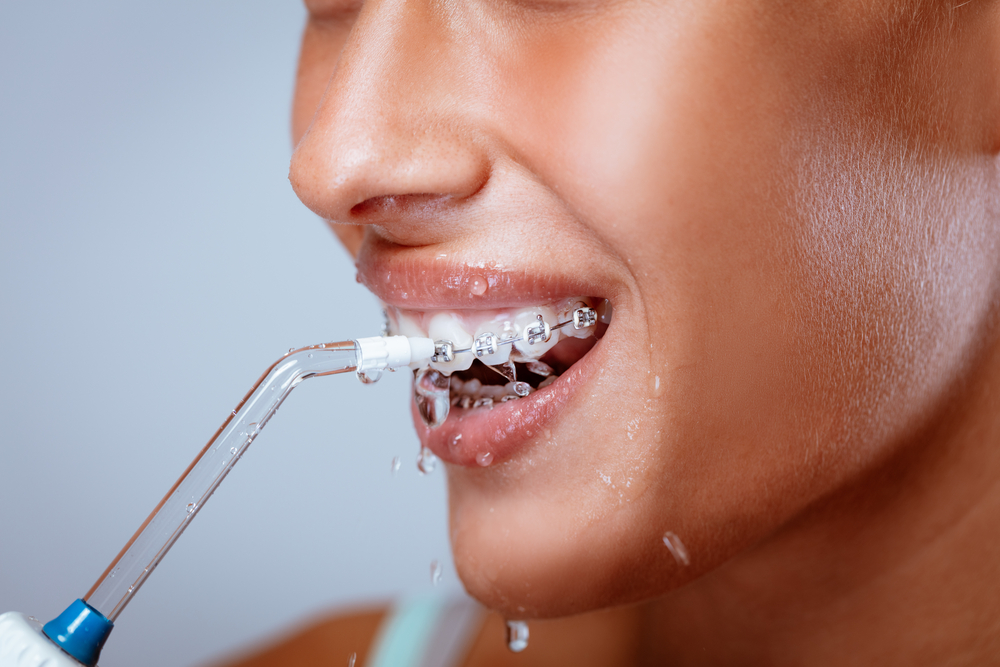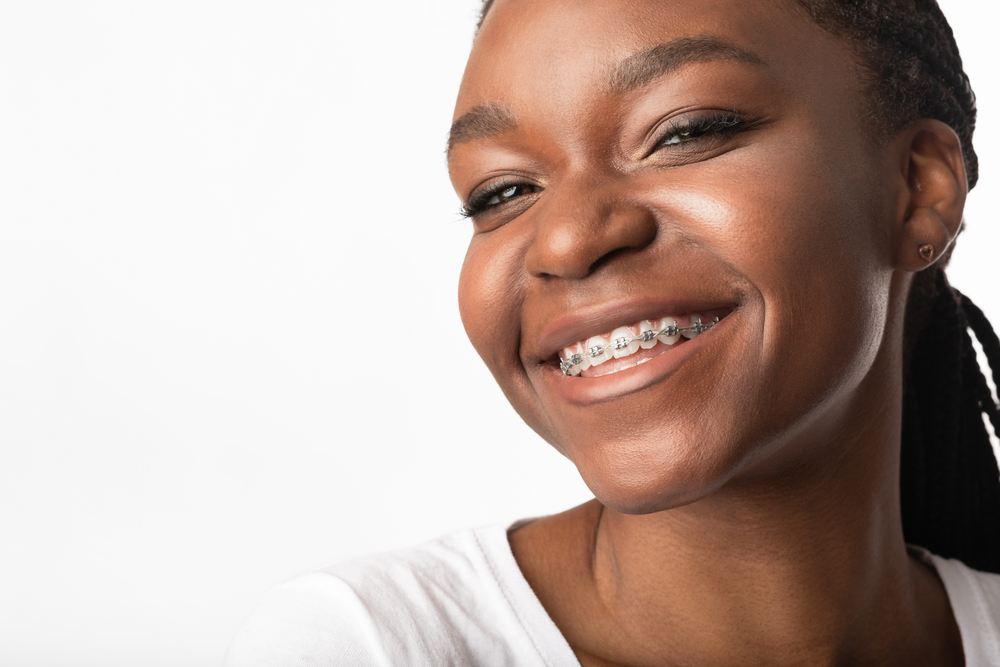Using a Waterpik® for braces is absolutely safe! A water flosser can be an excellent tool to help you get in those hard-to-reach nooks and crannies to keep your teeth sparkling clean. However, our Shorewood and Naperville braces patients sometimes wonder, can a waterpik replace flossing with braces? The answer is, no. You’ll need to use your waterpik in addition to flossing. To a lot of patients, taking this extra oral hygiene step is completely worth it because it really helps and leaves you with super clean, healthy teeth and gums.
In this post we’ll cover:
- What is a waterpik?
- The benefits of using a waterpik for braces
- How tools like a water flosser can prevent stained teeth from braces
- How to use a waterpik with braces
- What’s the best waterpik for braces?
WHAT IS A WATERPIK?
Waterpik is actually a brand of water flosser. It’s sort of like how Ziploc® has become eponymous with all plastic baggies or some people call all types of tissues a Kleenex®. A water flosser, also referred to as a powered interdental cleaner if you want to get really technical, is a handheld device comprised of a reservoir filled with water. It also has a motor and a pump that create a stream of pressurized water to push the water out of the reservoir through the tip and into your mouth. The water streams through your teeth and under your gums and is powerful enough to get rid of food particles, plaque and bacteria. It also stimulates your gums to improve their health. The process is comfortable and simple once you get the hang of it.
THE BENEFITS OF USING A WATERPIK FOR BRACES
As we said before, a waterpik is not a substitute for flossing. The water doesn’t penetrate as well as floss does, especially between crowded teeth. That doesn’t mean, however, that water flossers don’t serve a purpose and have a host of benefits. Some of the reasons we often recommend using a waterpik for braces are:
- A water flosser is excellent for helping dislodge pieces of food that get stuck under wires or in tight spaces in your mouth.
- The water pulsates, which massages the gum tissue, increasing circulation.
- Waterpiks are effective for cleaning under the gum line.
- A study published in the American Journal of Orthodontics and Dentofacial Orthopedics found that a water flosser with a specialized orthodontic jet tip helped reduce plaque and bleeding gums in teenagers with braces.
- Using a waterpik for braces gives you extra insurance that you’re eliminating plaque as best as you possibly can. Since it can be more difficult to clean around brackets and floss under wires, you can experience plaque build up, which, in turn, can eventually lead to cavities and gum disease. Anything you can do to wash away plaque is a bonus, especially since you’ll want your new smile to be healthy on all levels.
HOW A WATER FLOSSER CAN HELP PREVENT STAINED TEETH FROM BRACES
Sometimes, patients are concerned they’ll have stained teeth from braces. The good news is, staining is completely preventable! As you can see from the waterpik benefits listed above, it’s a real hero in the oral hygiene department. In fact, using a waterpik, along with diligent brushing and flossing, and eating a healthy diet will ward off stains or white spots from braces.
What are Braces Stains?
You can have yellow or brown stains on your teeth when your braces come off due to cavities, using tobacco products or enjoying a lot of acidic or highly-pigmented foods and drinks. However, more often than not, braces stains show up as white spots on the teeth around or just under where the braces brackets were. These white spots are areas of tooth decalcification, or very early decay. Essentially, your brackets give plaque and bacteria more places to hide and, if not removed, the plaque releases acids that erode tooth enamel and cause a loss of minerals, or decalcification.
These white spots after braces will sometimes fade a little bit over time. You can also opt for a treatment like ICON Infiltration, which stops decay from progressing and gets rid of the white spots by blending them in with the rest of your enamel. If you have stained teeth after braces due to other causes, seeking dental treatment for any oral health concerns like cavities and scheduling a professional teeth whitening session will remove stains and give you a brighter smile. Yet, your best bet is prevention, which is where your trusty water flosser comes in!
Avoiding Stained Teeth From Braces
Eating a healthy, well-rounded diet that’s low in sugar and simple carbohydrates when you have braces will help to strengthen enamel and prevent decalcification of the teeth. You may also want to minimize your intake of highly-pigmented and acidic foods and drinks like lemon juice, orange juice, red wine, coffee, citrus fruits, energy drinks and soda because these too can contribute to braces stains.
While diet will offer some protection, excellent oral hygiene is the number one way to avoid stained teeth from braces. Flossing your teeth once daily and brushing your teeth in the morning, after meals and snacks, and before bed will banish a significant amount of the plaque that can result in white spots after braces. Yet, you might not be able to reach every area around your brackets, which is where white spots tend to crop up, with a toothbrush and floss. A water flosser can often get into these tight spaces around your brackets, between your teeth and along the gumline. This combination of flossing, brushing and using a waterpik will ensure no plaque is left behind and braces stains don’t develop.
HOW TO USE A WATERPIK WITH BRACES
There are a variety of different waterpik tips, however, studies suggest a specialized orthodontic tip is the most effective for braces patients. Here is how to use a waterpik with braces step by step:
- Adjust the pressure. One of the best waterpik tips is to start at low pressure until you get used to the sensation. Once you have the pressure where you want it, lean over so your mouth is over the sink and put the tip of the water flosser in your mouth.
- Turn your waterpik unit on. Close your lips to keep the water from splashing and let it flow from your mouth into the sink.
- Start at your back teeth. Point the tip towards your gum line. Lightly brush in between your teeth, around your bracket and under your wire before moving on to the next tooth.
- Use your waterpik once a day. You’ll also want to floss with braces once daily using an orthodontic flosser or a product such as Super Floss. Brush using fluoride toothpaste and an electric toothbrush in the morning, after meals and snacks, and before bed.
WHAT’S THE BEST WATERPIK FOR BRACES?
When it comes to the best waterpik for braces, opt for one that has the American Dental Association’s seal of approval. However, it’s less about the actual tool and more about the waterpik tips. A specialized orthodontic tip has a tapered brush and will give you the best results because it’s designed especially for cleaning between and around fixed orthodontic appliances like braces. Replace your tip every three months.
Now that you know the ins and outs of using a waterpik for braces, are you ready to get a smile you love? Book an in-person or virtual consultation with a Naperville or Shorewood orthodontist at Innovative Orthodontic Centers today!





